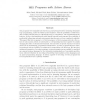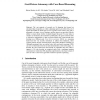81
Voted
ICLP
2010
Springer
15 years 4 months ago
2010
Springer
Abstract. Bottom-up evaluation is a central part of query evaluation / program execution in deductive databases. It is used after a source code optimization like magic sets or SLDm...
86
Voted
ICLP
2010
Springer
15 years 4 months ago
2010
Springer
hex programs were originally introduced as a general framework for extending declarative logic programming, under the stable model semantics, with the possibility of bidirectional...
ICLP
2010
Springer
15 years 4 months ago
2010
Springer
This paper presents a compiler from expressive, relational specifications to logic programs. Specifically, the compiler translates the Imperative Alloy specification language to...
105
click to vote
ICLP
2010
Springer
15 years 4 months ago
2010
Springer
Abstract. Reasoning about social networks (labeled, directed, weighted graphs) is becoming increasingly important and there are now models of how certain phenomena (e.g. adoption o...
126
click to vote
ICLP
2010
Springer
15 years 4 months ago
2010
Springer
Abstract. In this doctoral work we aim at developing a new approach to labelled semantics and equivalences for the Concurrent Constraint Programming (CCP) which will enable a broad...
ICCBR
2010
Springer
15 years 4 months ago
2010
Springer
In previous papers we have presented our autonomous poker playing agent (SARTRE) that uses a memory-based approach to create a betting strategy for two-player, limit Texas Hold’e...
100
click to vote
ICCBR
2010
Springer
15 years 4 months ago
2010
Springer
The concept of diversity was successfully introduced for recommender-systems. By displaying results that are not only similar to a target problem but also diverse among themselves,...
98
Voted
ICCBR
2010
Springer
15 years 4 months ago
2010
Springer
In this paper we present an approach for reducing the memory footprint requirement of temporal difference methods in which the set of states is finite. We use case-based generaliza...
85
Voted
ICCBR
2010
Springer
15 years 4 months ago
2010
Springer
In this paper we study the topic of CBR systems learning from observations in which those observations can be represented as stochastic policies. We describe a general framework wh...
100
click to vote
ICCBR
2010
Springer
15 years 4 months ago
2010
Springer
The vast majority of research on AI planning has focused on automated plan recognition, in which a planning agent is provided with a set of inputs that include an initial goal (or ...




